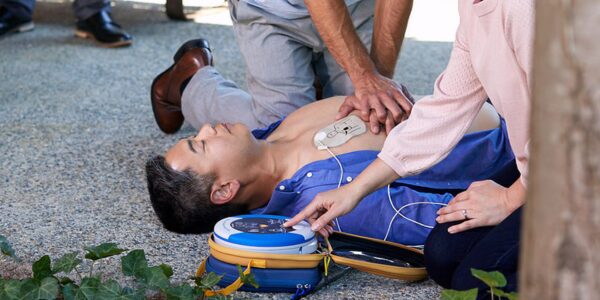HEALTH
Workplace Safety: Surviving Sudden Cardiac Arrest

According to recent reports from the medical sector, cardiac arrest is responsible for 30 percent of deaths worldwide. When people go into sudden cardiac arrest, their chances of surviving, or even making it to the hospital, are about 20 percent at best. When someone springs into action and administers CPR and other lifesaving techniques, though, their chances greatly improve.
If you were at work and one of your coworkers suddenly went into cardiac arrest, would you know what to do? Most people wouldn’t. When an emergency like this arises in a public place, people often stand idly by waiting for someone else to step in. Some are afraid to intervene, but must just don’t know how. Unfortunately, that often ends up being fatal for victims. If you’d like to be the one who does step up, learning CPR is recommended. In the meantime, read on to learn the steps to take to help save a life.
Know the Symptoms of Cardiac Arrest
One of the most effective measures in saving a cardiac arrest victim’s life is knowing which symptoms to look for. In cardiac arrest, the heart stops working. That means it’s no longer pumping blood to the body. Because of that, many people faint within just a few seconds. Many other problems can cause fainting as well, but cardiac arrest is certainly one of the most common.
In the few seconds before cardiac arrest causes a loss of consciousness, the victim may experience other telltale symptoms. Those include pain in the chest and left arm. Many feel dizzy, lightheaded, or nauseous as well. An unusually fast or pounding heartbeat is also a common warning sign.
Quick Intervention
If you suspect a coworker is suffering from cardiac arrest, acting quickly is essential. Have someone call emergency responders immediately. Check the person’s pulse rate. Having no pulse is a surefire sign that the person is suffering from cardiac arrest. Begin CPR if you’re trained to do so. Otherwise, the emergency dispatcher may talk you through the process. At this point, the recommended technique is 30 chest compressions to two breaths.
Stay on the phone with emergency responders and keep giving the victim CPR until help arrives. When the heart stops working it’s not pumping oxygenated blood to the rest of the body. Chest compressions keep circulation going so the victim’s brain and other vital organs won’t be starved of blood, oxygen, and nutrients. Once emergency responders arrive, they’ll take over for you.
Using an AED
CPR helps keep a victim’s blood circulating, but an automated external defibrillator can also be an important lifesaving tool. Many public places make them available in easy-to-reach places so they can be used when needed. Find out if your workplace does the same. If it does, be sure you know exactly where these devices are in case you ever need to use them.
One of the wonderful things about AEDs is that you don’t really need any medical experience to use them. They provide simple instructions on how to attach the pads to the patient, turn on the device, and proceed from there. They automatically read the victim’s heartbeat and determine whether to deliver a shock. You don’t need to control the device; it’s programmed to do everything for you. All you have to do is place the pads on the victim per the device’s instructions.
Knowing What to Do in a Cardiac Arrest Emergency
If you know what to do in a cardiac arrest emergency, you could save a person’s life. CPR and using an AED both greatly improve a cardiac arrest victim’s chance of survival. Understanding the warning signs to look for, how to perform CPR, and where the AEDs in your workplace are located will help you quickly spring into action when needed.
Kenneth is a proud native of sydney, born and raised there. However, he pursued his education abroad and studied in Australia. Kenneth has worked as a journalist for almost a decade, making valuable contributions to prominent publications such as Yahoo News and The Verge. Currently, he serves as a journalist for The Hear Up, where he focuses on covering climate and science news. You can reach Kenneth at [email protected].










